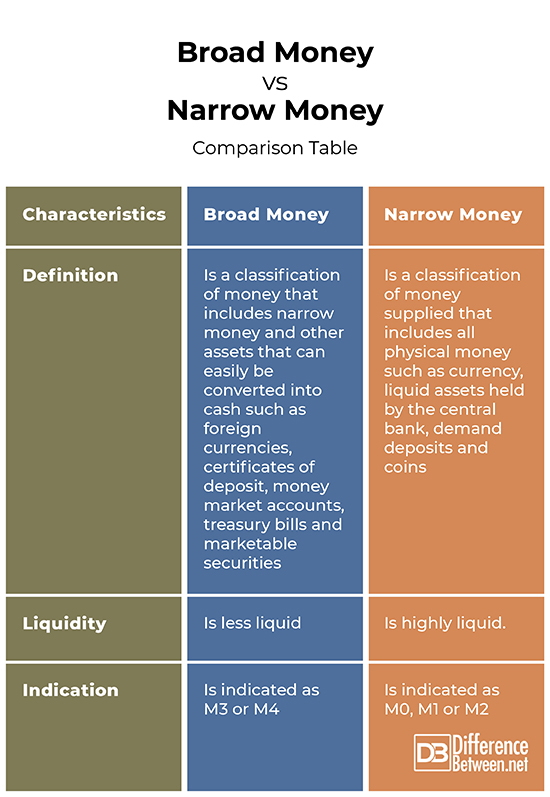Difference Between Broad Money and Narrow Money
Money is a medium of exchange. In the past, other mediums such as barter trade, gold or silver were used as a medium of exchange of goods. While these are still used based on cultures, money remains the main medium of exchange. For most people, money is just that: money. However, the definition of money varies based on regions. That being said, different countries have a measure for broad money and narrow money. But what is the variance between the two? Let’s explore.

What is Broad Money?
Broad money is a classification of money that includes narrow money and other assets that can easily be converted into cash such as foreign currencies, certificates of deposit, money market accounts, treasury bills and marketable securities. It is used to measure the amount of money in circulation and is also considered the most inclusive money supply method in a country.
Countries have varying methods of calculating broad money. Let’s take a look at a few.
- In Canada, broad money includes all items in M0 and M1 and other items such as foreign currency, time savings deposits, plus travellers’ checks and securities repurchase agreements.
- In the United States, M2 is the broadest money and consists of all items in M1 along with money market deposits, savings deposits, time deposit accounts and money market funds.
- In the United Kingdom, M4 and M3H are considered broad money. They include all items in M1 and M2 and other items such as foreign currency deposits, certificates of deposits and building society deposits among others.
- In Australia, M3 is broad money that consists of all items in M1 and credit unions and building societies with banks. Other items classified into broad money in Australia include non-bank deposits and holdings of currency.
- In Japan, M3 is broad money that consists of all items in M1 and M2 and deposits at post offices, banks as well as savings.
Broad money is less liquid.

What is Narrow Money?
This is a classification of money supplied that includes all physical money such as currency, liquid assets held by the central bank, demand deposits and coins. As we mentioned, the actual definitions of money used by central banks and governments vary in different nations. However, every country has a measure of narrow money. Narrow money is identified by an M that is followed by digit(s) or a letter.
Here are some examples of how Narrow money is identified in some nations:
- In Canada, narrow money is classified as M0 and M1. It includes notes and coins in circulation as well as assets that are easy to convert to cash.
- In the United States, the country has two main measures of money, M1 and M2 with M1 being the narrowest. Narrow money (M1) in the United States includes all currency that is in circulation, demand deposits, travellers’ checks and checkable deposits.
- In Australia, narrow money is indicated as M1. It consists of bills in circulation, coins and bank current deposits.
- In the United Kingdom, M1 is the narrowest money and consist of bankers’ deposits and the currency in circulation. M2 and M4 follow closely as narrow money.
- In Japan, M1 is the narrowest money and includes deposits, coins and the bills in circulation. This is closely followed by M2 which includes deposits, coins, the bills in circulation and certificates of deposits.
The liquidity for narrow money is high. As such, it is easily available as per demand.
Similarities between Broad Money and Narrow Money
- Both are definitions of money
- Both vary across different countries
Differences between Broad Money and Narrow Money
Definition
Broad money is a classification of money that includes narrow money and other assets that can easily be converted into cash such as foreign currencies, certificates of deposit, money market accounts, treasury bills and marketable securities. On the other hand, narrow money is a classification of money supplied that includes all physical money such as currency, liquid assets held by the central bank, demand deposits and coins.
Liquidity
Broad money is less liquid while narrow money is highly liquid.
Indication
Broad money is indicated as M3 or M4 while narrow money is indicated as M0, M1 or M2.
Broad Money vs. Narrow Money: Comparison Table

Summary of Broad Money vs. Narrow Money
Broad money is a classification of money that includes narrow money and other assets that can easily be converted into cash such as foreign currencies, certificates of deposit, money market accounts, treasury bills and marketable securities. It is less liquid hence is not easily available for spending. On the other hand, narrow money is a classification of money supplied that includes all physical money such as currency, liquid assets held by the central bank, demand deposits and coins. It is highly liquid and is easily available for spending.
FAQ:
What is the difference between base money and broad money?
Base money is the total amount of money that is held by the central bank reserves and that which is in circulation. On the other hand, broad money is the total amount of money that can easily be converted into cash such as foreign currencies, certificates of deposit, money market accounts, treasury bills and marketable securities.
What is narrow money and broad money in India?
Narrow money (M1 & M2) in India includes all notes and coins in circulation and all demand deposit components. Broad Money (M3 & M4) in India includes all components in narrow money and commercial banks net time deposits, term deposits and term borrowings.
Which is called as narrow money?
Narrow money includes all physical money such as currency, liquid assets held by the central bank, demand deposits and coins.
- Difference Between Profit Center and Investment Center - July 2, 2022
- Difference Between Anti-Trust and Anti-Competition - June 6, 2022
- Difference Between Stocktaking and Stock Control - June 6, 2022
Search DifferenceBetween.net :
1 Comment
Leave a Response
References :
[0]Sriram S & Lim E. Factors Underlying the Definition of Broad Money: An Examination of Recent U.S. Monetary Statistics and Practices of Other Countries. International Monetary Fund, 2003. https://books.google.co.ke/books?id=AFQYEAAAQBAJ&printsec=frontcover&dq=Difference+between+Broad+Money+and+Narrow+Money&hl=en&sa=X&ved=2ahUKEwjr4KK4o8D1AhVNxoUKHS_YAIUQ6AF6BAgKEAI#v=onepage&q=Difference%20between%20Broad%20Money%20and%20Narrow%20Money&f=false
[1]Tim Congdon. Money in a Free Society: Keynes, Friedman, and the New Crisis in Capitalism. Encounter Books, 2011. https://books.google.co.ke/books?id=rNdtWVK9_rMC&printsec=frontcover&dq=Difference+between+Broad+Money+and+Narrow+Money&hl=en&sa=X&redir_esc=y#v=onepage&q=Difference%20between%20Broad%20Money%20and%20Narrow%20Money&f=false
[2]Shin H & Chung K. Global Liquidity through the Lens of Monetary Aggregates. International Monetary Fund, 2014. https://books.google.co.ke/books?id=q1cZEAAAQBAJ&printsec=frontcover&dq=Difference+between+Broad+Money+and+Narrow+Money&hl=en&sa=X&ved=2ahUKEwjr4KK4o8D1AhVNxoUKHS_YAIUQ6AF6BAgGEAI#v=onepage&q=Difference%20between%20Broad%20Money%20and%20Narrow%20Money&f=false

Could anyone enlightened which of the curency value most in each of the countries mentions? Regard.